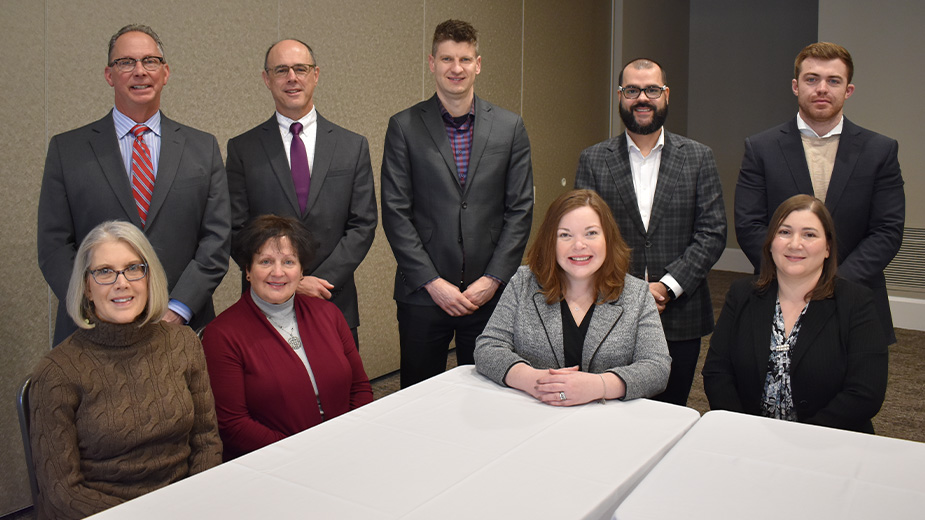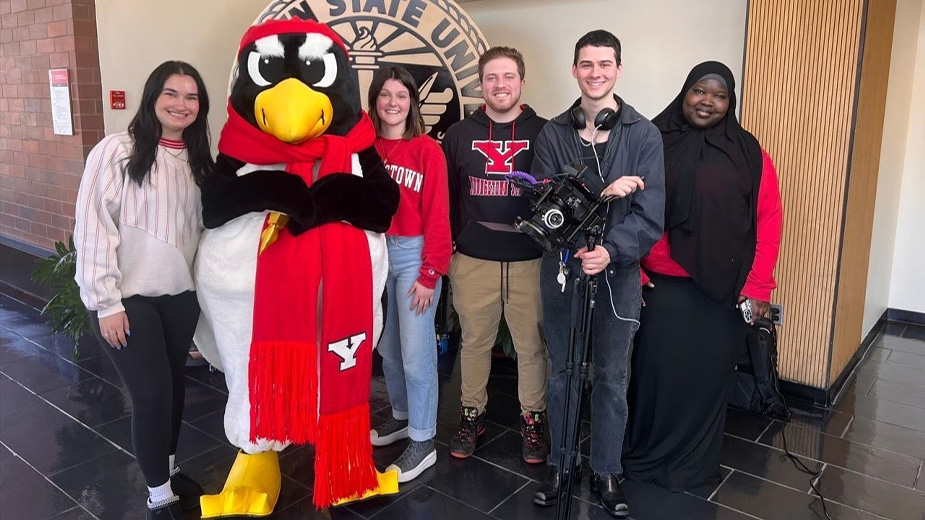Roundtable Preview: Valley Repopulation Demands Group Effort
CANFIELD, Ohio – Repopulating the Mahoning Valley will be a years-long and multifaceted process that must involve a community-wide effort, experts say.
The Business Journal convened a roundtable of business, nonprofit and community leaders Feb. 15 at Waypoint 4180 to talk about repopulation, its challenges and the steps involved. The full transcript of the discussion will be printed in the mid-March issue.
“We’ve seen unprecedented opportunities to grow our economy,” said Guy Coviello, president and CEO of the Youngstown/Warren Regional Chamber. “The No. 1 barrier has been workforce, so we’ve taken up growing our population as our top priority for us to build the workforce and keep up with the demand.”
Coviello was joined at the roundtable discussion by Jim Kinnick, executive director of Eastgate Regional Council of Governments; Angelica Diaz, executive director of OCCHA; Julie Michael Smith of the Mahoning Valley Manufacturers Coalition; Nancy Voitus, executive director of the Catholic Charities Regional Agency; Lisa Long, CEO designate and the financial resource development director at the Youngstown Jewish Federation; Jake Rickert, project program coordinator at Penn-Northwest in Mercer County; Christopher Colón, co-director and co-founder of Thrive Mahoning Valley; and Emil Liszniansky, principal of Envision.
The Regional Chamber and Eastgate are leading the Valley repopulation effort, and Lisznianaky is a consultant working with Eastgate.
They’re focused on a three-pronged approach, or the three R’s: retain young people, return people who have left the area and receive refugees.
Post-Covid, the Valley is seeing record leads for economic development projects and significant job growth from large companies, Coviello said.
He referred to the December announcement that consumer products giant Kimberly-Clark bought land in Trumbull County for a manufacturing plant as well as Foxconn in Lordstown.
Both of those companies offer good pay and benefits for employees.
“Those companies are going to get their workers …” Coviello said.
If the Valley doesn’t grow its population to provide those workers, they’ll come from the small, family-owned mom and pop operations, and those businesses won’t survive, he said.
Kinnick said the Valley has seen five decades of population loss.
“If you just look at the city of Youngstown, it was a city of 160,000 people,” he said. “It’s down to 60,000.”
That shows there’s already a shortage of people in the area. With large companies coming to the area, that can cause a worker shortage, Kinnick said.
The median age of Valley workers is also older than the national average.
“It really just magnifies the need to keep younger people in our area or bring younger people back to our area,” he said.
Rickert said population is a leading factor in the economic health of a region.
“A healthy, growing population stimulates economic opportunities, higher income, availability of economic resources, recreation, innovation,” he said, pointing to Austin, Texas, as an example.
That city is growing by about 50,000 people per year with the slogan “Keep Austin Weird.” People of all ages are moving there, Rickert said.
Mercer County, by contrast, has lost 30,000 people, leading to significant workforce shortages, he said.
“It’s increasingly important that we keep young people here and retain the young adults attending our local educational systems,” Rickert said.
Smith said that from the manufacturing perspective, MVMC is interested in all three R’s.
“We’re very focused on retaining youth, keeping them in our community,” she said.
That also involves figuring out how to make manufacturing careers appealing to young people, Smith said.
“Beyond that, how do we create a community that’s attractive?” she said.
Liszniansky said the first step is looking at what other communities have done.
One example is Utica, New York, a post-industrial, legacy rust belt community that saw its population drop from 100,000 to 40,000. It shares similarities with Youngstown.
“What they did was go all in on embracing refugees,” Liszniansky said. “That started back in about 1980, and since then they’ve started building their population slowly upward,” Liszniansky said.
About 25% of Utica residents are foreign born.
“What they did was create a welcome center,” he said. “We’re kind of using this model to have a similar multifaceted facility here in Youngstown …”
That would connect refugees with employment, housing and wraparound services.
Long said the Youngstown Jewish Federation has partnered with the Regional Chamber in the repopulation effort.
“There’s a lot of communities like ours, so why reinvent the wheel,” she said.
The agency has reached out to Jewish federations and other groups doing similar work, including those in Kansas City, Tulsa and Greensboro.
The federation brought people from Ukraine to the Valley during the crisis in that country. In the 1980s, the federation brought former Soviet Jews from the U.S.S.R. to the Valley and settled those families here.
“We’re looking to bring back and bring in more Jewish families to the area and, really, bring back families of all faiths because if we can make Youngstown a more attractive place to live, then it will attract all families,” Long said. “With a rising tide, all of our ships go up.”
A lot of organizations have worked on repopulation independently, but so many working together, like what’s happening now, is what it’s going to take, she said.
Voitus said refugee resettlement is an important part of repopulation, and Catholic Charities Regional Agency wants to be part of it.
The Diocese of Youngstown has a contract with the Diocese of Cleveland for immigration legal services.
“When we’re talking about recruiting in the form of refugee resettlement, I think it’s important that the community understand refugees are people who are leaving their home country for a variety of reasons, but usually because they are forced out,” Voitus said.
We want to be that welcoming community, she said, to help them with housing, education and other challenges.
Diaz said OCCHA was created in 1972 because the Latino community was coming to the area from Puerto Rico.
The organization provides wraparound services like food and clothing. Families coming to the area don’t know where to go for help.
“That’s where our staff comes in and helps them navigate the system, whether it be housing, whether it be employment. So we’ve been doing this since 1972, and we’re still doing this today,” Diaz said.
Colón said Thrive Mahoning Valley has been working to spread the stories of people who move to the area from other places. They’ve convened community conversations. One was conducted from the Latin American perspective, and more are planned from the Asian American and Middle Eastern perspective.
“We’re looking to advocate for the communities to put policies in place that align with the Welcoming America Welcoming Standard, which we’ve been championing for five years as well,” Colon said.
Liszniansky said data shows that immigrants and refugees are 30% more likely to start a small business than those who are native born.
Coviello said the Regional Chamber doesn’t support welcoming undocumented immigrants or anything that’s going to put a stress on services.
“Our members cannot hire an undocumented immigrant,” he said. “We are careful to use the term legal immigration.”
They want to attract refugees through organizations like Catholic Charities to make sure they’ve been vetted and that they’ll work to be self-sufficient.
There are a lot of other ways the community needs to focus on repopulation, though, Coviello said.
“To some extent, the immediate solution for our organization, the chamber and our members is tapping into the underserved population that is already here,” he said.
Efforts need to extend to enticing people who have left the area to return, too.
“I think we’re our own worst enemies because we don’t talk about the good things going on in the area,” Kinnick said. “The quality of life is a major issue for economic development and our young people. The people who have left need to hear about the good things going on.”
He listed as examples the downtowns coming back, the area being close to both Cleveland and Pittsburgh, the Covelli Centre and the amphitheaters in Youngstown and Warren.
Reinvestment in areas along the Mahoning River is another positive change, he said.
“It’s going to be a community effort,” Kinnick said. “We’re going to need our business partners, and we’re certainly going to need everybody talking about the good things going on here.”
Panelists also talked about the need for more housing and housing that meets the needs of the people they’re trying to attract. That will require changes in public policies.
Pictured at top: Front row, from left: Julie Michael Smith, Nancy Voitus, Lisa Long and Angelica Diaz. Back row, from left: Jim Kinnick, Guy Coviello, Emil Liszniansky, Christopher Colón and Jake Rickert.
Copyright 2024 The Business Journal, Youngstown, Ohio.



